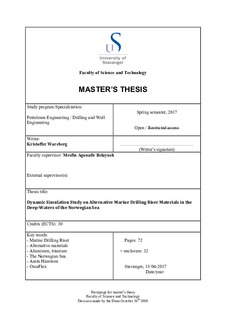| dc.description.abstract | In the pursuit of more oil and gas to meet the growing demand and replace the declining
production, the offshore industry is pushed to invest, explore and drill new wells in
deeper waters with harsh environments and with a possibility of HPHT wells and sour
well flows. Drilling risers with strength and corrosion resistance capable of handling
these extreme conditions are accordingly required. As the water depth increases, the
length and weight of the riser might lead to problems in terms of; increased loadings
on the handling equipment and tensioner system, as well as storage and transportation
limitations. Today, the conventional riser material is steel. Steel is a strong and
relatively cheap material. However, it is heavy and not very corrosion resistant. Hence,
the industry has turned its focus to lighter alternative materials. Aluminum and
titanium risers with their light weight, high strength-to-weight ratio and good corrosion
resistance are potential candidates to substitute the heavy steel risers.
In order to assess aluminum and titanium as alternative materials in riser design
and determine if they are suitable for operations in the harsh environment in the
Norwegian Sea, simulation studies in OrcaFlex has been conducted. The environmental
data used in the simulations are from the Aasta Hansteen gas field, in an area of the
Norwegian Sea where the water depth is about 1200 m. The output from the simulation
software are compared with the ISO standard 13624 to find the maximum flex joint
angles and von Mises stress.
The results from the dynamic simulations show that wave height and drilling fluid
density influences the effective tension, flex joint angles and the von Mises stress. The
applied top tension proves to have the biggest impact on the results, and should be
closely considered during the design phase.
Aluminum and titanium both proves to fulfill the given design parameters, and can
potentially be an alternative to the conventional steel riser in drilling operations in the
Norwegian Sea. However, long term properties such as fatigue and corrosion should be
investigated to get the full understanding. | nb_NO |
